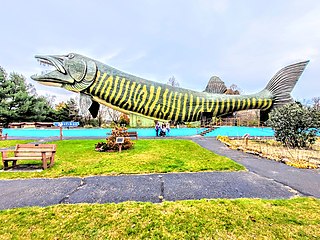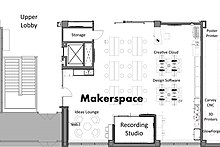
Portage County is a county in the U.S. state of Wisconsin. As of the 2020 census, the population was 70,377. Its county seat is Stevens Point.

Oconto County is a county in the U.S. state of Wisconsin. As of the 2020 census, the population was 38,965. Its county seat is Oconto. The county was established in 1851.

Marathon County is a county located in the U.S. state of Wisconsin. As of the 2020 census, the population was 138,013. Its county seat is Wausau. It was founded in 1850, created from a portion of Portage County. At that time the county stretched to the northern border with the Upper Peninsula of Michigan. It is named after the battlefield at Marathon, Greece.

Lincoln County is a county located in the U.S. state of Wisconsin. As of the 2020 census, the population was 28,415. Its county seat is Merrill. The county was created in 1875 and named after President Abraham Lincoln. Lincoln County comprises the Merrill, WI Micropolitan Statistical Area, which is also included in the Wausau-Stevens Point-Wisconsin Rapids, WI Combined Statistical Area.

McFarland is a village in Dane County, Wisconsin, United States, situated on Lake Waubesa. As of the 2024 census, the village has a population of 9,597. A suburb of Madison, it is part of the Madison metropolitan area.

Wisconsin Rapids is a city in and the county seat of Wood County, Wisconsin, United States, along the Wisconsin River. The population was 18,877 at the 2020 census. It is a principal city of the Marshfield–Wisconsin Rapids micropolitan statistical area, which includes all of Wood County and had a population of 74,207 in 2020.

Marshfield is a city in Wood and Marathon counties in the U.S. state of Wisconsin. The population was 18,929 at the 2020 census; of this, 18,119 were in Wood County and 810 were in Marathon County. It is a principal city of the Marshfield–Wisconsin Rapids micropolitan statistical area, which includes all of Wood County and had a population of 74,207 in 2020.

Hayward is a city in Sawyer County, Wisconsin, United States, next to the Namekagon River. Its population was 2,533 at the 2020 census. It is the county seat of Sawyer County. The city is surrounded by the Town of Hayward. The City of Hayward was formally organized in 1883.

The Miss Wisconsin competition is the pageant, held annually in Oshkosh, that selects the representative for the U.S. state of Wisconsin in the annual Miss America pageant.

Wausau East High School is a public secondary school in Wausau, Wisconsin. It serves grades 9-12 for the Wausau School District.
Markham Public Library (MPL) is a library system operated by the municipal government of the City of Markham in Canada. There are eight branches in the city, serving about 250,000 residents in Markham. The libraries are managed by the Administration Centre, located at 6031 Highway 7.
Alexander Chadbourne Eschweiler was an American architect with a practice in Milwaukee, Wisconsin. He designed both residences and commercial structures. His eye-catching Japonist pagoda design for filling stations for Wadham's Oil and Grease Company of Milwaukee were repeated over a hundred times, though only a very few survive. His substantial turn-of-the-20th-century residences for the Milwaukee business elite, in conservative Jacobethan or neo-Georgian idioms, have preserved their cachet in the city.

Ferry & Clas was an architectural firm in Wisconsin. It designed many buildings that are listed on the National Register of Historic Places. George Bowman Ferry and Alfred Charles Clas were partners.
The Tampa–Hillsborough County Public Library System (THPL) is a public library system based in Hillsborough County, Florida, United States. It is part of two larger library networks, the Tampa Bay Library Consortium, and the Hillsborough County Public Library Cooperative, which includes Temple Terrace Public Library in Temple Terrace, and Bruton Memorial Library in Plant City. There are 33 branches of the Hillsborough County Public Library Cooperative.

The Pasco County Library Cooperative (PCLC) is the public library system that serves all residents of Pasco County, Florida, and is a member of the Tampa Bay Library Consortium. The Pasco County Library System, as it was originally known, was established by county ordinance in 1980.

The James Weldon Johnson Community Library is a public library located in St. Petersburg, Florida. It is a branch of the St. Petersburg Library System, which services a large area in southern Pinellas County, Florida. African Americans were barred from using the Carnegie Library built in 1915. In 1944 they were granted access to its basement and in 1945 a separate library was established for black patrons. The current library was designed by Miami architect Charles Canerday & Associates. It was built in 2002.

The Centennial Planetarium, located at 701 11 Street SW in Calgary, Alberta, was designed by Calgary architectural firm McMillan Long and Associates and opened in 1967 for the Canadian Centennial, it is one of Calgary's best examples of Brutalist architecture, winning several awards open its opening. As of 2019, the building houses Contemporary Calgary, a public art gallery.
The Riverview Public Library is part of the Tampa–Hillsborough County Public Library System and the Hillsborough County Public Library Cooperative. The library is located in Hillsborough County, Florida.
Alice in Dairyland is a one-year, full-time public relations professional employed by the Wisconsin Department of Agriculture, Trade, and Consumer Protection (DATCP). Each year, Alice in Dairyland travels more than 40,000 miles throughout the state, promoting Wisconsin agriculture to various audiences. Additionally, she conducts hundreds of media interviews, speeches and school presentations. Applications for this rewarding role are accepted each January.
Bernard R. Goggins was an American lawyer and the first mayor of Wisconsin Rapids, Wisconsin.


















